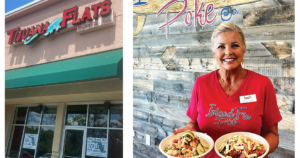 Romulo “Romy” Camargo rolls past Derrik Amarral, who is working hard with physical therapists to bring legs that were damaged in a car accident back to life.
Romulo “Romy” Camargo rolls past Derrik Amarral, who is working hard with physical therapists to bring legs that were damaged in a car accident back to life.
“Come on, Derrik,’’ Romy encourages Amarral. “Let’s go!”
Across the room, 69-year-old Vietnam War veteran William Stevens is lifting a weighted bar, screaming loudly as his personal trainers urge him on.
Meanwhile, Gabriella (“Gaby”) Camargo, Romy’s wife, smiles as she looks out from her office.
At the Stay in Step Spinal Cord Injury (SCI) Recovery Center in Tampa, a 5,000-sq.-ft. haven for paraplegics, quadriplegics and those who have suffered traumatic brain injuries, it is not uncommon to see Romy trying to fire up those fighting through a workout.
Conveniently located in the University Center Drive Business Park off N. 30th St. (near both the University of South Florida and the James A. Haley Veteran’s Hospital), Romy and Gaby are reaching beyond just service to wounded war veterans. So Amarral, a civilian who drives from Spring Hill, works side-by-side with Stevens, a military vet. “It’s very important people know that this is for military and civilians,” Gaby says.
Romy — who is serving as the 2016 Gasparilla Parade of Pirates Grand Marshall this weekend — and Gaby have devoted their lives to helping wounded warriors, many who battle daily to remain viable and healthy despite having lost the use of their legs, their arms and, in many cases, both.
 On Valentine’s Day (Sunday, February 14), 5:30 p.m.-9 p.m., All American Music Productions is hosting the “Valentines For Veterans” benefit dinner at the Stone Chef Events facility in Ybor City. All proceeds go to support Romy and Gaby’s Stay in Step Foundation, a 501(c)(3) nonprofit organization.
On Valentine’s Day (Sunday, February 14), 5:30 p.m.-9 p.m., All American Music Productions is hosting the “Valentines For Veterans” benefit dinner at the Stone Chef Events facility in Ybor City. All proceeds go to support Romy and Gaby’s Stay in Step Foundation, a 501(c)(3) nonprofit organization.
“We can’t do what we do without the support of the community,’’ Gaby says.
Continuing To Serve…
While on a humanitarian mission in Afghanistan in 2008, Chief Warrant Officer 3 Romy Camargo and his fellow soldiers in the Green Beret 7th Special Forces Group were ambushed in Zabul Province by Taliban fighters.
As they scrambled to dodge a hailstorm of rocket-propelled grenades and machine-gun fire, a bullet smashed into the back of Romy’s neck.
Bullets continued to fly as an emergency tracheotomy was performed on Romy, saving his life. The soldiers managed to repel the attack and get to safety, and Romy was flown to Germany and then to Walter Reed National Military Medical Center in Washington, D.C. It was on Gaby’s birthday — September 19, 2008 — when he arrived at Walter Reed.
Romy was hooked up to countless wires and machines, a ventilator so he could breathe, and he was lucky to be alive. The bullet had shattered his C3 vertebrae. He was paralyzed from the shoulders down. Doctors said he would never breathe on his own, but Romy is always proud to say he proved them wrong.
Doctors also told him he would never walk again. Romy told Gaby the doctors were wrong on that claim as well, as he continues to strive towards his goal of one day getting out of his wheelchair forever.
Thus began the toughest mission of the Green Beret’s life.
He spent 18 months at Walter Reed before he could leave. Shortly thereafter, he petitioned the Surgeon General of the U.S. Army for permission to try an aggressive treatment to help him recover. In May of 2011 in Lisbon, Portugal, he became the first active duty service member to receive Olfactory Mucosa Autografts, where stem cells from the base of his nose were used to stimulate the recovery of his injured spine.
Romy couldn’t distinguish temperatures and tell if the weather was hot or cold before the surgery, but he could after the treatment. It was a big moment. Since that surgery four-plus years ago, he says he has had no setbacks and he has seen great improvement. The surgery, however, required intensive rehabilitation. For two-and-a-half years, Romy drove to Longwood, FL, to work out at Project Walk Orlando. He says the twice-a-week commute sometimes felt as gruelling as the workouts, taking as long as 4-5 hours round trip, but it was worth it.
”It was a great place, it was awesome,’’ Romy says. “And it made me stronger.”
 Gaby, however, had an idea to start their own facility, to do the same great work here in the Tampa Bay area. They began raising money. As they approached the grand opening date of the Stay In Step SCI Recovery Center in June of 2015, Toyota contributed $300,000 to give the Camargos the $1.2 million total they needed to launch.
Gaby, however, had an idea to start their own facility, to do the same great work here in the Tampa Bay area. They began raising money. As they approached the grand opening date of the Stay In Step SCI Recovery Center in June of 2015, Toyota contributed $300,000 to give the Camargos the $1.2 million total they needed to launch.
The center currently services roughly 20-30 clients with its action-based therapy and family- and team-oriented treatment, and the Camargos hope to have 50 patients and even more someday.
But, they also understand the trouble some have in paying for treatment, and that everyone does not have the support and connections they had. One of Gaby’s goals this year is to begin a supplemental program, to help pay for an hour or two of time for clients who can’t afford to pay.
The money they hope to raise at the Valentines for Veterans event will go towards that cause, and they also recently received a $300,000 donation from the U.S. Special Forces Charitable Foundation.
“This is such important work,” Gaby says, “that we want to take off some of the financial burden.”
 Because of the seriousness of many of the injuries they see, Romy and Gaby know how important it is for their patients to remain as active as possible despite their physical limitations. The long-term process, they say, is as much mental as it is physical. While Romy, who retired from the service after 20 years in October, doesn’t promise anyone they will ever walk again, he does promise to make them feel better and stronger, which will improve their quality of life.
Because of the seriousness of many of the injuries they see, Romy and Gaby know how important it is for their patients to remain as active as possible despite their physical limitations. The long-term process, they say, is as much mental as it is physical. While Romy, who retired from the service after 20 years in October, doesn’t promise anyone they will ever walk again, he does promise to make them feel better and stronger, which will improve their quality of life.
“It’s attitude,’’ he says. “Never give up. These guys are happy to be here. They come and work out and they want to come more. That’s why we’re so thankful for the donations we receive, so they can help with the financial burden. This is a family issue for most of them.”
To that end, the Stay in Step facility doesn’t just boast top-of-the-line equipment — like the $115,000 RT600 that provides electrical stimulation to patients working out in the standing position, or the $30,000 RT300 that does the same for those in a sitting position — it also has a playroom stocked with books, art supplies and video games for children. For adults, there is a home-like waiting area, designed like a living room with comfortable furniture, computers with internet connections and warm surroundings.
“Everything is state of the art,’’ Romy says, proudly.
That includes the people who work there, he says. The employees include lead trainer Steven Hill, the Special Forces medic who performed the emergency tracheotomy that saved Romy’s life, and certified trainers who are invested and passionate, Romy says. The center’s medical advisor is Dr. John Merritt, MD, one of Romy’s doctors at Walter Reed and the retired chief of the Spinal Cord Injury Center at the Haley’s Veteran’s Hospital.
 Romy, who directs his hi-tech motorized wheelchair (equipped with an iPad and iPhone that he operates with a mouth stick) that operates on sensors he can trigger via his headrest, couldn’t be happier to give back. He takes the greatest pleasure in seeing the same fight he has in those trying to recover, — and pushing them even further.
Romy, who directs his hi-tech motorized wheelchair (equipped with an iPad and iPhone that he operates with a mouth stick) that operates on sensors he can trigger via his headrest, couldn’t be happier to give back. He takes the greatest pleasure in seeing the same fight he has in those trying to recover, — and pushing them even further.
Having circled the facility to give a tour, Romy looks back at Amarral and Stevens, whose progress continues to be marked by decibels as he achieves a personal best in the weight he is hoisting. Romy motions his head towards them, offering more words of encouragement to both of them.
Amarral looks over and smiles.
“These guys are awesome,’’ he says, loudly. “This place is awesome.”
The Stay in Step Spinal Cord Injury Recovery Center is located at 10500 University Center Dr., Suite 130, in Tampa. Visit StayInStep.org for more info. For about the “Valentines For Veterans” gala, visit AllAmericanMusicEvents.com.




No comment yet, add your voice below!